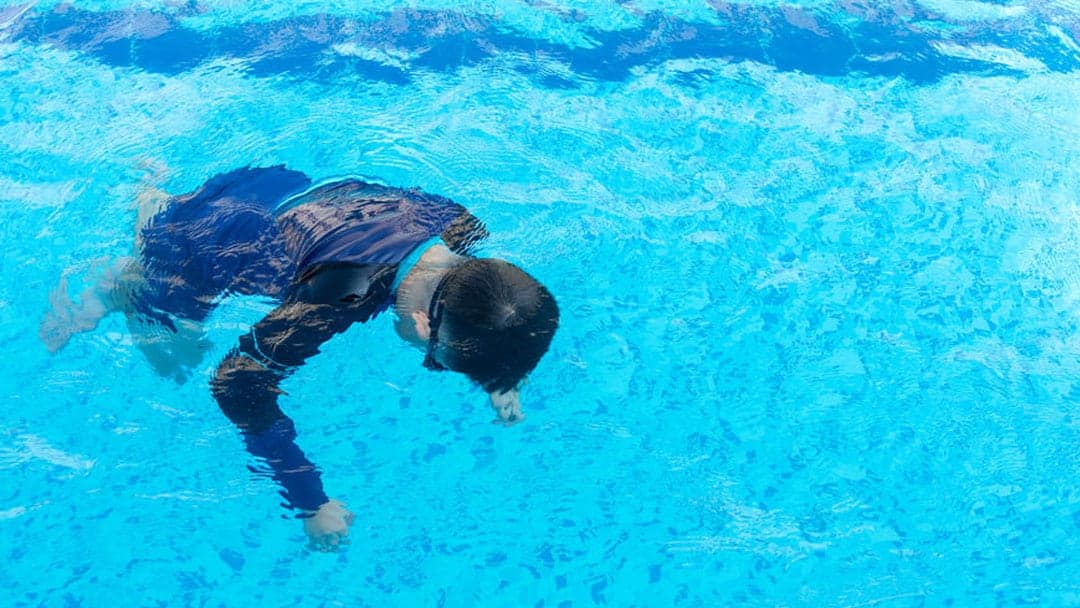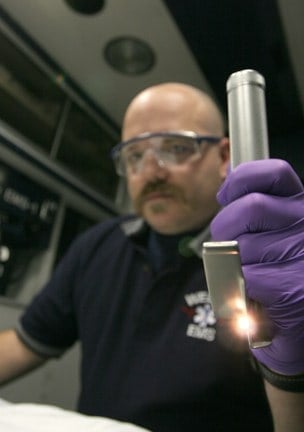
Limmer Education

by Chris Ebright
Our articles are read by an automated voice. We offer the option to listen to our articles as soon as they are published to enhance accessibility. Issues? Please let us know using the contact form.
EMS is called to a residence to assist in the search for a missing child. At the scene, EMTs are informed that numerous officers are combing a four-block area for a three-year-old male that wandered away from his uncle’s home. The uncle states he was filling a cooler with ice in the kitchen, where his nephew was playing. Turning away for what seemed to be a minute, when he looked back, his nephew was nowhere to be found. He looked around the immediate area and found the back porch door wide open. Immediately, the uncle called 9-1-1 and began searching for the boy in the back and front yards, to no avail. Police arrived within minutes of the call and subsequently requested EMS to aid in the search. As the EMS crew continues questioning the uncle, a call comes over an officer’s radio. A child matching the nephew’s description has been found, floating face down in a swimming pool, two houses away.
Drowning is a common and often preventable cause of death, with significant risk factors that include gender, time of year, lack of supervision, history of epilepsy, and alcohol and drug use. Unfortunately, in the United States, it is the second leading cause of injury-related death among children one to four years old, with a death rate of three per 100,000.
For every child who dies, another five receive emergency medical care for a non-fatal submersion injury, with half of those children admitted to a hospital for further care.
Over all age groups, drowning accounts for almost 13,000 emergency department visits per year and about 3,500 deaths.
Boys are more likely to drown than girls, and children aged between one and four are at the highest risk, followed by teenagers. Typically in the warmer weather months, the number of drowning incidents increases as more and more people are swimming in pools, rivers, and lakes. However, within a home is another, albeit rarer, scene for a drowning. Buckets, bathtubs, and toilets all provide a potential source of drowning for toddlers and infants. The younger the child is, the more likely they are to fall head-first into the water due to their higher center of gravity.
Lack of adult supervision does have an impact on drowning incidents, but one particular study found that parents were present in 62 percent of drowning deaths within the home. However, many of these documented cases revealed that the parents/caregivers were under the influence of alcohol, drugs, or had become distracted.
Alcohol and illicit drug use is a common risk factor for teenagers. It is estimated that the risk of a fatal drowning is ten times higher with a person with a blood-alcohol level of 0.1 when compared to someone sober.
Lastly, for people with epilepsy, the risk of drowning is fifteen to nineteen times as high when compared to those who do not have epilepsy. Interestingly, studies also reveal that when supervision is present, children with seizure disorders have no higher risk of drowning than children without a seizure disorder.
The boy is not moving, nor responding to the officers’ voices, in the two-foot shallow end of the pool. When the EMS crew arrives from the uncle’s house and assess the situation, they mutually decide to make entry into the pool. Being careful not to cause excessive waves, one of the EMTs wades in and maintains in-line cervical stabilization while the other EMT wades in behind her with a backboard. The EMT holding the child’s c-spine rolls underwater rotating the child supine, then floats him onto the backboard. Also, on the scene, with her mother present, the police are talking with a twelve-year-old girl.
She states she was watching TV in the living room when she heard a splash. Running out to the pool, the girl saw the victim thrashing in the water, unable to get himself out. He went underwater once, came back up, and then went under again. At that point, she couldn’t reach the boy and ran out of the backyard shouting for her mother, who was in the front yard. It was then the girl, and her mother encountered an officer searching for the boy and told her what was happening. The officer then radioed in the call.

The World Health Organization adopted a standard definition of drowning in 2002 as “the process of experiencing respiratory impairment from submersion/immersion in liquid.” The process begins when a victim’s airway goes below the surface of a liquid (submersion), or when water splashes over the victim’s face (immersion). If the victim is rescued at any time, the process is interrupted and termed a non-fatal drowning. If the victim dies at any time, then this is termed a fatal drowning.
Currently, only these two terms are medically accepted. There are many other terms: “Near drowning,” “dry drowning,” “wet drowning,” “delayed drowning,” “active and passive drowning,” and “secondary drowning” that should no longer be used to describe a drowning event, as they are inaccurate and misleading.
When a victim can no longer keep his or her airway clear, water entering the mouth is voluntarily spat out or swallowed. The next conscious response is to breath-hold, but this lasts for no more than about a minute. The instinct to breathe takes over, and the victim inhales, aspirating water into the upper and lower airways. Coughing, and sometimes a laryngospasm, occurs – which previously was thought to protect the lower airways, but does not. Laryngospasm is rare, occurring in less than two percent of cases, and even then, it rapidly relaxes with the onset of brain hypoxia.
If the victim is not rescued, aspiration of water continues, and the resultant hypoxemia quickly leads to a loss of consciousness and apnea. The whole drowning process, from submersion/immersion to respiratory/cardiac arrest, takes seconds to no more than a few minutes. However, with special circumstances such as hypothermia or drowning in ice water, the sequence of events can take up to an hour or longer.
Another prevailing thought affecting the outcome is the type of water to which the victim is exposed. The presence of any fluid within the alveoli causes surfactant cells to malfunction, and the surfactant is washed out. Regardless, aspiration of saltwater or freshwater causes similar degrees of injury. Both disrupt the alveolar-capillary membrane, increasing its permeability, and promote a shift of extracellular fluid and plasma into the alveoli.
The boy is not breathing, so rescue ventilations are initiated in the water as he is secured to the backboard. Once the boy is brought out of the water and placed on land, an ALS EMS crew arrives. The new crew members quickly reassess the child and determine that he is in cardiac arrest. The EMTs initiate CPR as the paramedics establish vascular access and attach their ECG monitor, which shows asystole. Before an advanced airway is placed, the boy vomits.
Immediately, the crews tilt the backboard and victim onto the left side, suction and clear his airway, then resume CPR with BVM ventilation and an oropharyngeal airway. Before attempting to move the boy, one of the paramedics successfully inserts a 4.5 mm endotracheal tube at the 13 cm mark and secures it. Correct tube placement is verified by bilateral chest rise and no epigastric sounds, but rales are auscultated throughout all lung fields.

Underwater, victims can’t inhale oxygen, and cerebral hypoxia occurs rapidly. Thus, the priorities of the management of a drowning victim include effective ventilation, oxygenation, and chest compressions. Regarding scene safety, rescuers must take care not to become victims themselves. Panicked victims will thrash about and grab at anything they encounter, potentially dragging a rescuer underwater. Safe rescue techniques include reaching to the drowning victim with an object such as a pole, towel, or tree branch or throwing something to them that will float. A rescuer must also take into account the same hazards that got the victim into trouble, such as strong currents or deep water.
If conscious, the victim should be moved to land, and appropriate basic life support care initiated immediately. With an unconscious victim, in-water resuscitation may increase the likelihood of a favorable outcome. However, this should only be attempted by highly-trained rescuers, and solely consist of assisted ventilation. Drowning victims presenting only with respiratory arrest usually respond after a few rescue breaths. If there is no response, the victim should be assumed to be in cardiac arrest and moved to land immediately.
Once on land, the victim should be placed supine, and a rapid initial assessment exam should be completed. If the victim is unconscious but breathing, place him or her in a recovery position and assess for adequate airway maintenance and ventilation. If the victim is apneic, assist ventilations, and if pulseless immediately begin CPR. The EMS professional should keep in mind that initial BVM ventilations may be ineffective. Water in the alveoli will interfere with its ability to expand effectively, and thus, may take multiple ventilations before any positive effects are observed.
BVM ventilation with a basic oropharyngeal and/or nasopharyngeal airway is sufficient during initial management. However, an advanced airway should be placed as soon as possible, especially for a victim with prolonged apnea. This is done for two reasons: One, ventilating, and oxygenating the victim becomes more efficient. Two, the risk of gastric insufflation, vomiting, and further aspiration by the victim is reduced. The most frequent complication during a resuscitation attempt is the regurgitation of stomach contents, which occurs in more than 65 percent of victims who require rescue breathing alone and in 86 percent of those who require CPR.
Once intubated, most victims can be oxygenated and ventilated adequately. Although copious amounts of fluid may appear in the endotracheal tube, balance the benefits of suctioning against the patient’s current oxygenation needs. EMS professionals should attain, then maintain by the most appropriate method, a SpO2 reading between 92 and 96 percent, as well as adequate and bilateral chest rise. Peripheral venous access is the preferred route for drug administration in the prehospital setting, but intraosseous access is an acceptable alternative in cases when venous access cannot be obtained.
The presenting rhythm in cases of cardiac arrest after drowning is usually asystole or pulseless electrical activity. Ventricular fibrillation is rare but may occur if the drowning victim has a history of coronary artery disease or is severely hypothermic. If ventilation and chest compressions do not result in a resuscitation, IV epinephrine administration should be considered. Remember, because the cardiac arrest is due to hypoxia and the effects of hypothermia, multiple doses may need to be administered to achieve the return of spontaneous circulation.
Ventilations continue with good compliance, despite the presence of a moderate amount of fluid in the ET tube. A decision is made not to suction the tube, as the SpO2 remains at 94 percent. Still pulseless and asystolic, compressions are continued as the boy is moved to the ambulance. Once in the back, the heat is turned on, correct ET tube placement is reconfirmed via breath sounds and capnography, and an appropriate dose of IV epinephrine is administered. Transport time to the ED is 7 minutes. Within a minute of the epinephrine administration, one of the paramedics observes sinus bradycardia on the ECG with a rate of 50 beats/minute.
A weak femoral pulse is palpated, and EtCO2 reads 55 mmHg, but the boy is still apneic. CPR is resumed for another two minutes, and a radio report is delivered to the ED. Soon after that, the boy starts to move his extremities and partially opens his eyes. The femoral pulse has increased to 110 beats/minute and is much stronger. To keep the ET tube in place, and for patient comfort, an appropriate dose of IV sedative is administered. The boy remains stable throughout the remainder of the transport, and care is transferred to the ED staff without incident. After five days in the hospital, the boy is discharged home – neurologically intact.

1. Borse NN, Gilchrist J, Dellinger AM, Rudd RA, Ballesteros MF, Sleet DA. CDC childhood injury report: patterns of unintentional Injuries among 0–19 year olds in the United States, 2000–2006. Atlanta: Centers for Disease Control and Prevention, 2008.
2. Centers for Disease Control and Prevention, National Center for Injury Prevention and Control. Injury Data. http://www.cdc.gov/injury/wisqars. Accessed November 30, 2019.
3. Centers for Disease Control and Prevention. Welcome to WISQARS. www.cdc.gov/injury/wisqars. Accessed December 1, 2019.
4. Centers for Disease Control and Prevention. WONDER. https://wonder.cdc.gov. Accessed December 1, 2019.
5. van Beeck EF, Branche CM, Szpilman D, Modell JH, Bierens JJLM. A new definition of drowning: towards documentation and prevention of a global public health problem. Bull World Health Organ 2005;83:853-856.
6. Szpilman D, Bierens JLM, Handley AJ, Orlowski JP. Drowning. N Engl J Med 2012; 366:2102-2110.
7. Morrongiello BA, Sandomierski M, Schwebel DC, Hagel B. Are parents just treading water? The impact of participation in swim lessons on parents' judgments of children’s drowning risk, swimming ability, and supervision needs. Accid Anal Prev. 2013; 50: 1169-1175.
8. Driscoll TR, Harrison JE, Steenkamp M. Alcohol and drowning in Australia. Inj Control Saf Promot. 2004; 11(3); 175-181.
9. Bell GS, Gaitatzis A, Bell CL, Johnson AL, Sander JW. Drowning in people with epilepsy: how great is the risk? Neurology 2008;71:578-582.
10. Szpilman D, Orlowski JP, Cruz-Filho FES. Hey “Near-drowning,” you’ve been messing up our minds! World Congress on Drowning. Amsterdam, 2002. www.researchgate.net/publication/267981173_HEY_Near-drowning_YOU%27VE_BEEN_MESSING_UP_OUR_MINDS. Accessed December 1, 2019.
11. Sterba JA, Lundgren CE. Diving bradycardia and breath-holding time in man. Undersea Biomed Res 1985;12:139-150.
12. Tipton MJ, Golden FS. A proposed decision-making guide for the search, rescue and resuscitation of submersion (head under) victims based on expert opinion. Resuscitation 2011;82:819-824.
13. Szpilman D, Elmann J, Cruz-Filho FES. Dry-drowning—fact or myth? World Congress on Drowning. Netherlands, 2002. www.researchgate.net/publication/267981164_Dry-drowning_-Fact_or_Myth. Accessed November 29, 2019.
14. Orlowski JP, Abulleil MM, Phillips JM. The hemodynamic and cardiovascular effects of near-drowning in hypotonic, isotonic, or hypertonic solutions. Ann Emerg Med 1989;18: 1044-1049.
15. Quan L, Wentz KR, Gore EJ, Copass MK. Outcome and predictors of outcome in pediatric submersion victims receiving prehospital care in King County, Washington. Pediatrics 1990; 86(4):586–593.
16. Manolios N, Mackie I. Drowning and near-drowning on Australian beaches patrolled by life-savers: a 10-year study, 1973-1983. Med J Aust 1988;148:165-171.
17. Szpilman D, Soares M. In-water resuscitation -- is it worthwhile? Resuscitation 2004;63:25-31.
18. Soar J, Perkins GD, Abbasc G, et al. European Resuscitation Council Guidelines for Resuscitation 2010. Section 8. Cardiac arrest in special circumstances: electrolyte abnormalities, poisoning, drowning, accidental hypothermia, hyperthermia, asthma, anaphylaxis, cardiac surgery, trauma, pregnancy, electrocution. Resuscitation 2010;81:1400-1433.
19. Szpilman D, Sempsrott J, Webber J, Hawkins SC, Barcala-Furelos R, Schmidt A, Catarina-Queiroga A. Dry drowning’ and other myths. Cleveland Clinic Journal of Medicine. 2018 July;85(7):529-535.
20. Dowd MD. Dry Drowning: Myths and Misconceptions. Pediatr Ann. 2017; 46(10):354-357.

Limmer Education

Limmer Education

Dan Limmer, BS, NRP
I was wondering why Dihydrogen Oxide in the title was not explained in the article.
Dihydrogen Oxide = Water (H20). I believe the author was creating a playful title.
I see what you did there - H2O :) Made me look.